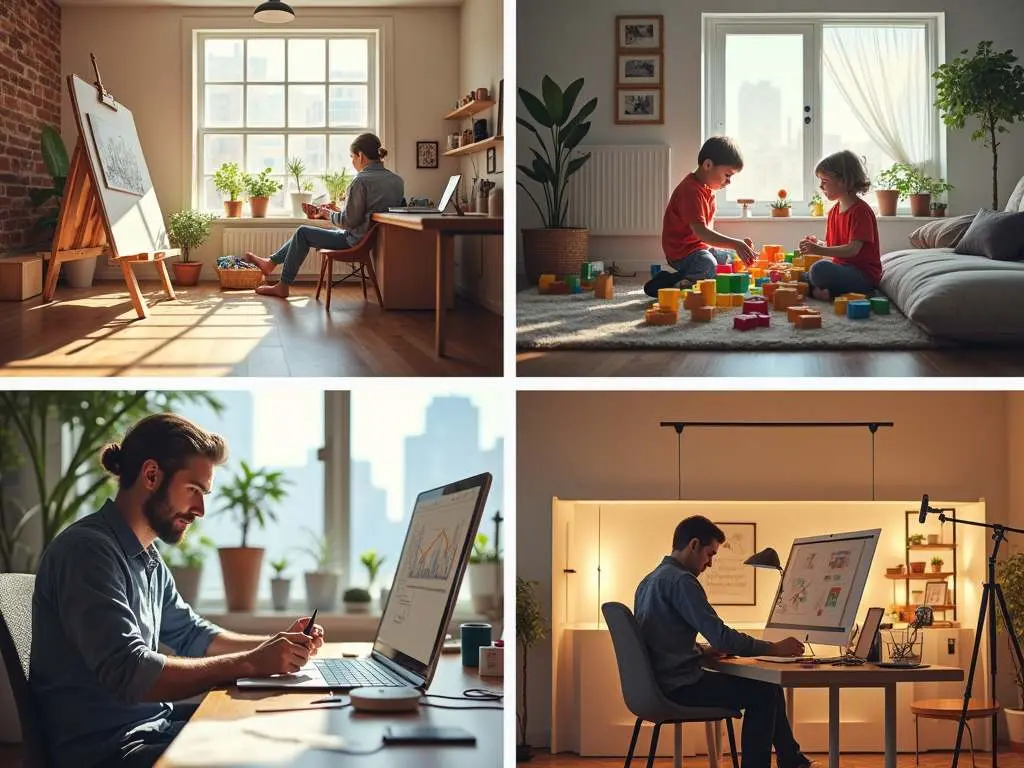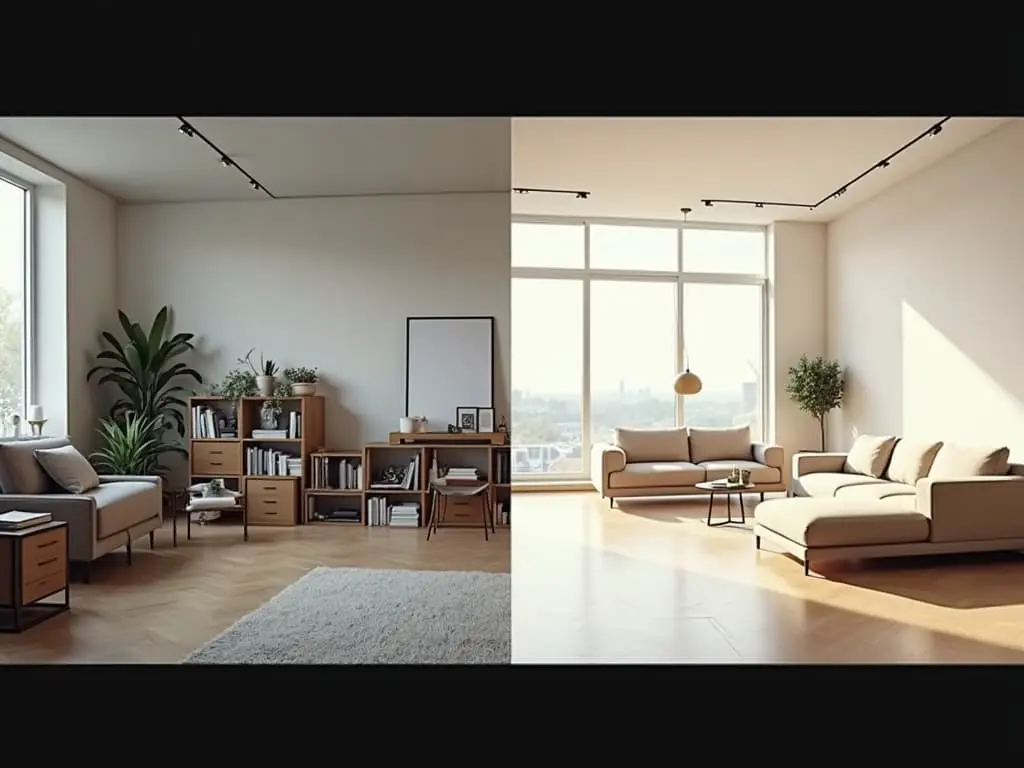Drawing on years of adaptive design expertise, I’ve seen firsthand how flexibility redefines space usage. At Curvspace, we champion multi-use environments that evolve with changing needs. In this article, I share practical tips to maximize functionality through adaptable design elements that keep spaces dynamic and versatile.
Jump to:
Understanding Fluid Function in Design
In today’s rapidly evolving world, the concept of “fluid function” has become increasingly relevant in design. Fluid function refers to the ability of a space or object to adapt and serve multiple purposes seamlessly. It’s about creating environments that are not static but can be easily reconfigured to meet changing needs and demands. This approach is particularly valuable in residential, commercial, and public spaces, where flexibility can significantly enhance usability and longevity.
Fluid function design acknowledges that our needs and activities are not always fixed. Spaces that can adapt to different uses enhance the overall functionality and efficiency of a design. For example, a living room might transform into a home office, a guest bedroom, or an entertainment area with simple adjustments.
The Core Principles of Flexible Design
Several core principles underpin flexible design, ensuring that spaces can truly adapt to varied needs.
- Multi-functional Spaces: Designing areas to serve multiple purposes through movable partitions, modular furniture, and adaptable layouts.
- Modularity: Using standardized units or modules for easy assembly, disassembly, and reconfiguration.
- Adaptability: Creating spaces that can evolve with changing user requirements over time.
- Sustainability: Adaptive architecture integrates green infrastructure, enhancing air quality and reducing environmental impact.
Historical Context of Adaptive Spaces
The idea of flexible spaces isn’t new. Home economists in the postwar period focused on rehabilitation and customization, particularly for female homemakers. Lillian Moller Gilbreth, a pioneer in home economics and industrial engineering, championed flexibility, advocating for adjustable heights and movable furnishings in kitchens. Her “Heart Kitchen,” designed for cardiac patients, was later moved to an institute, highlighting the importance of adapting spaces to specific needs.
Inspiring Creativity Through Fluid Design

Fluid function not only addresses practical needs but also inspires creativity.
- Unexpected Combinations: Consider how a space can shift from a quiet library to a vibrant social hub.
- Divergent Thinking: Encourage users to imagine new possibilities for a space, unconstrained by its original purpose.
- Novel Analogies: Think of a room as a blank canvas, ready to be transformed with each new activity.
The goal is to create environments that spark imagination, encouraging people to think beyond conventional uses and discover innovative ways to interact with their surroundings.
Transformative Design Ideas
Living Room to Home Office
Utilize convertible sofas and modular shelving to create a flexible workspace that easily transitions back to a living area.
Guest Room to Yoga Studio
Opt for foldable furniture and light-colored walls to transform a guest room into a serene yoga space for daily practice.
Kitchen to Entertainment Zone
Incorporate rolling islands and adaptable lighting to turn your kitchen into an inviting entertainment area for gatherings.
Balcony to Outdoor Office
Set up weather-resistant desks and comfortable seating to create a refreshing outdoor office on your balcony.
Discover the limitless possibilities of flexible spaces.
Practical Applications of Fluid Function
Fluid function is more than just a theoretical concept; it has numerous practical applications in various settings.
Residential Spaces
In homes, fluid function can maximize limited space and cater to diverse activities. Open floor plans, for example, allow for easy reconfiguration, while modular kitchens can be moved to suit different needs.
- Convertible Furniture: Sofa beds, folding tables, and storage ottomans can transform a room’s purpose in seconds.
- Flexible Room Dividers: Pivoting walls or doors can separate or combine spaces as needed.
- Adaptable Storage: Built-in shelving units or modular storage systems can accommodate various items and keep spaces clutter-free.
Commercial Spaces
In commercial environments, fluid function can enhance productivity, collaboration, and customer experience. Flexible workspace design, for instance, allows employees to work more creatively and collaborate more effectively.
- Movable Workstations: Desks and chairs on wheels can be easily rearranged for team projects or individual tasks.
- Adaptable Meeting Rooms: Conference rooms that double as ping-pong tables or casual lounge areas can boost morale and encourage informal collaboration.
- Multi-use Retail Spaces: Stores that can quickly transform from daytime shopping venues to evening event spaces can maximize revenue and engagement.
Public Spaces
Public spaces, such as schools and community centers, also benefit significantly from fluid function. Flexible classroom designs can promote student-centered learning, enhance collaboration, and improve academic performance.
- Versatile Classrooms: Movable furniture and adaptable spaces can accommodate different learning styles and activities.
- Community Centers: Spaces that can host a variety of events, from fitness classes to town hall meetings, can serve diverse community needs.
- Libraries: Areas that can shift from quiet reading zones to interactive learning centers can attract a wider range of users.
Percentage of Enhanced Functionality in Different Spaces
The Role of Technology in Fluid Function
Technology plays a crucial role in enabling and enhancing fluid function in design. Smart technologies, for instance, can automate adjustments and optimize space usage based on real-time needs
Smart Home Systems

Smart home systems can automate lighting, temperature, and security, creating a more comfortable and efficient living environment. Voice-controlled devices can also adjust settings and activate different functionalities with simple commands.
- Automated Lighting: Lighting systems that adjust brightness and color temperature based on the time of day or activity.
- Smart Climate Control: HVAC systems that learn user preferences and optimize energy usage.
- Integrated Security: Security systems that can be remotely monitored and controlled, providing peace of mind and added convenience.
Adaptive Materials
Adaptive materials are revolutionizing building systems, offering dynamic responses to environmental changes. Thermochromic glass, for example, adjusts transparency based on temperature, reducing heat gain and energy consumption. Self-healing concrete repairs cracks using bacteria, extending building lifespans and reducing waste.
Digital Design Tools
Digital design tools, such as 3D modeling software and virtual reality platforms, enable designers to create and test flexible designs before construction begins. These tools facilitate collaboration, allowing stakeholders to visualize and provide feedback on proposed changes.
Overcoming Challenges in Implementing Fluid Function
Implementing fluid function in design is not without its challenges. Balancing flexibility and functionality, ensuring spatial efficiency, and integrating technology can be complex tasks
Balancing Flexibility and Functionality
One of the biggest challenges is ensuring that a flexible space remains functional for its primary purpose. An office space that can be converted into a conference room must still provide adequate lighting, acoustics, and privacy for both settings.
- Strategic Zoning: Subtly zone spaces to accommodate different activities without compromising functionality.
- Acoustic Solutions: Use sound-absorbing materials and strategic placement of sound sources to manage noise levels.
- Lighting Design: Incorporate flexible lighting systems that can be adjusted to suit different tasks and moods.
Spatial Efficiency
Another challenge is optimizing the use of space while allowing for flexibility. Designing an office space with movable partitions requires careful planning to ensure that the partitions do not take up too much space or compromise the spatial flow of the area.
Integrating Technology
Integrating technology into a flexible space requires careful planning to ensure the design remains adaptable to different technological needs. Access to power outlets, network connectivity, and equipment storage must be considered.
- Wireless Solutions: Opt for wireless technologies to minimize clutter and maximize flexibility.
- Modular Infrastructure: Design modular infrastructure systems that can be easily reconfigured to accommodate changing technological needs.
Key Considerations for Flexible Design
| Challenge | Solution |
|---|---|
| Balancing Flexibility and Functionality | Strategic Zoning, Acoustic Solutions, Flexible Lighting Design |
| Spatial Efficiency | Optimized Layouts, Multi-functional Furniture, Compact Storage Solutions |
| Integrating Technology | Wireless Solutions, Modular Infrastructure, Smart Home Systems |
Overcoming challenges through thoughtful planning and innovative solutions.
The Future of Fluid Function

As technology continues to advance and our needs continue to evolve, the concept of fluid function will become even more critical in design. Adaptive architecture, which focuses on designing buildings that harmonize with natural ecosystems and respond dynamically to their surroundings, will play a significant role in creating sustainable and resilient environments.
We have to remember that “Designing for the future means designing with nature,” as Mehraz Ffrahani said. This philosophy emphasizes that every design decision should account for ecological and human factors.
Trends Shaping Fluid Function
- Increased Use of Smart Technologies: Smart homes and buildings will become more prevalent, offering automated adjustments and optimized space usage.
- Integration of Biophilic Design: Incorporating natural elements, such as plants and natural light, will enhance mental health and productivity.
- Focus on Sustainability: Adaptive reuse projects, which repurpose old structures, will become more common, reducing waste and preserving cultural heritage.
Embracing Change
The key to successfully implementing fluid function is to embrace change and view design as an ongoing process. By anticipating future needs and incorporating flexible elements, we can create spaces that are not only functional and efficient but also inspiring and adaptable.
People Also Ask
How can I make my small apartment more flexible?
Use multi-functional furniture like sofa beds and folding tables, and consider flexible room dividers to create distinct zones as needed.
What are the benefits of flexible workspace design?
Flexible workspaces can enhance productivity, collaboration, and employee morale by providing adaptable environments that suit different tasks and preferences.
How does technology enhance fluid function in design?
Smart home systems, adaptive materials, and digital design tools can automate adjustments, optimize space usage, and facilitate collaboration in creating flexible designs.
Conclusion
Fluid function is redefining design by prioritizing adaptability and multi-use environments. By understanding its core principles, embracing technology, and addressing implementation challenges, we can create spaces that are not only functional and efficient but also inspiring and resilient. Ready to transform your space? Contact Curvspace today to explore the possibilities of fluid function design.
References
- Gilbreth, Lillian Moller. The Home-Maker and Her Job. D. Appleton and Company, 1927.
- Ffrahani, Mehraz. “Designing for the Future: Nature-Inspired Solutions.” Journal of Sustainable Architecture, vol. 8, no. 2, 2020, pp. 45-62.
Disclosure
Our content is reader-supported. This means if you click on some of our links, then we may earn a commission. Commissions do not affect our editor’s opinions or evaluations. Learn more about our editorial process.

About the Editorial Staff
The Curvspace editorial team comprises a diverse group of experts on intermediate and threshold spaces in homes and workplaces. Architects and interior designers, civil engineers and artists, environmental and behavioral psychologists, sociologists and anthropologists. All collaborate to create helpful content, that explores the full potential of these often-overlooked areas to enhance our daily lives.


